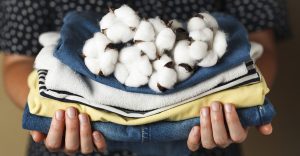Ever wonder how much water was used to make your favorite cotton T-shirt? About 2,700 liters, or roughly three years of drinking water. What first comes to mind is probably the water that was essential to growing the cotton crop. Surprisingly, cotton is a drought-tolerant plant, and often less recognized is the strain that can be put on water resources to dye cotton textiles.
Progress is being made across the industry to lessen the strain on our precious water resources. Over the past several years, Dow has collaborated with Cotton Incorporated to research and validate Dow’s product — ECOFAST™ Pure Sustainable Textile Treatment — that can help drastically reduce water and chemical use during the dyeing process. Major fashion brands like Ralph Lauren are integrating it into their supply chain to dye more sustainably, without sacrificing color or quality.
Problem
Cotton dyeing is very resource-intensive and puts strain on local waterways. A large amount of water is used in the dyeing process — up to 5 trillion liters a year, or nearly enough to supply all of humanity with drinking water. Significant amounts of chemicals and dye are needed to get the desired colors consumers expect too. This is part of the reason textile mills account for 20 percent of industrial water pollution globally. Wastewater from the dyeing process can be polluting and require costly treatment and these challenges are found in regions that already face water scarcity.
Solution
Reforming processes in an industry as established as textiles is no easy feat. Collaboration across the sector is needed to bring about sustainable change. With that in mind, Cotton Incorporated approached Dow. They wanted help scaling a cotton technology to support more sustainable textile dyeing. It turned out we were developing a similar technology that had improved performance, and we were looking for help too. Leveraging Cotton Incorporated’s industry expertise and Dow’s material science knowledge, we worked together to understand and validate the benefits of our patented ECOFAST Pure Sustainable Textile Treatment.
How Can Colors Be More Responsible?
ECOFAST Pure is a pretreatment applied before the dyeing process to produce cationic cotton. This means the charge of cotton is permanently changed from negative to positive, so it acts like a magnet to attract negatively charged dye to the material. How does that benefit the textile mill? It significantly decreases the amount of water, chemicals, dye and energy needed to color cotton. A third party reviewed and validated life cycle assessment, available by request, helped further prove the benefits.

Click to watch the LCA video
Why Is Collaborating Across The Value Chain Essential?
Collaboration is critical for change to be meaningful and sustainable. As a not-for-profit focused on conducting research to benefit every link in the cotton supply chain, Cotton Incorporated has a unique expertise that complements our own. Working with Cotton Incorporated gave important insights about our product in application. Insights that would have taken much longer to discover without the industry expertise they offered.
Together we were able to evaluate the benefits of ECOFAST Pure compared to existing cationic chemistries. This was critical, because cationic cotton isn’t a new concept and this research helped prove our new product was advantaged over others — including no odor in application. We were also able to test compatibility across a variety of popular dyes, connect with expert consultants and more through this collaboration.
Still, Cotton Incorporated and Dow are only two players at two distinct points in the textile value chain. Like we’ve seen in our work with Ralph Lauren, we have to reach further — collaborating with brands, mills and others — to color cotton with integrity. Will you join us?
June 16, 2021





